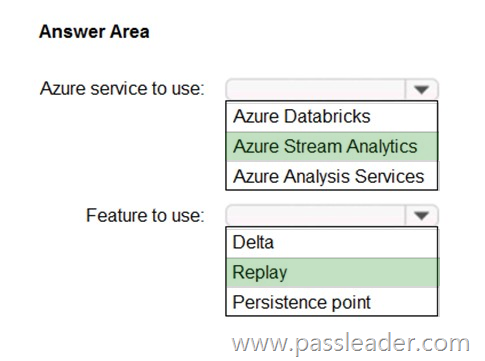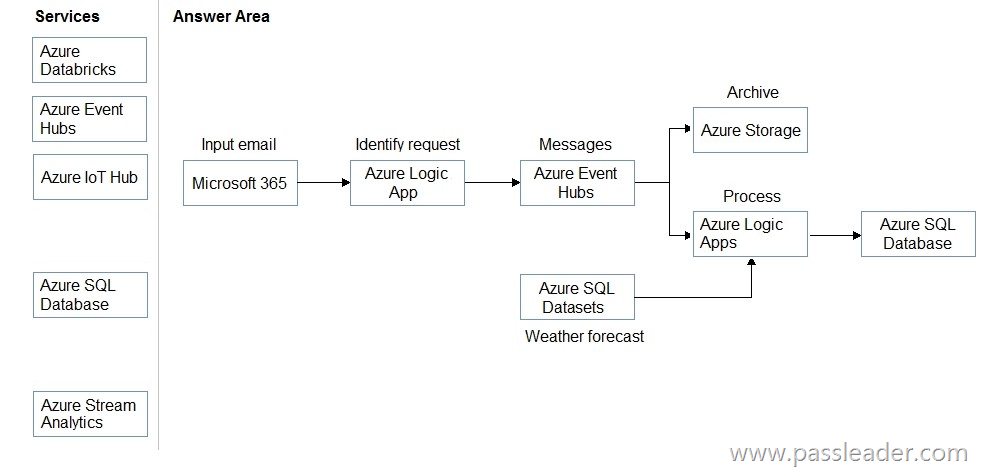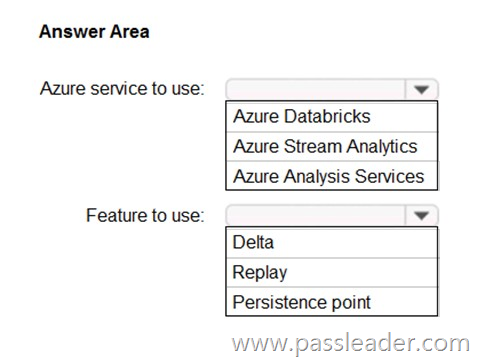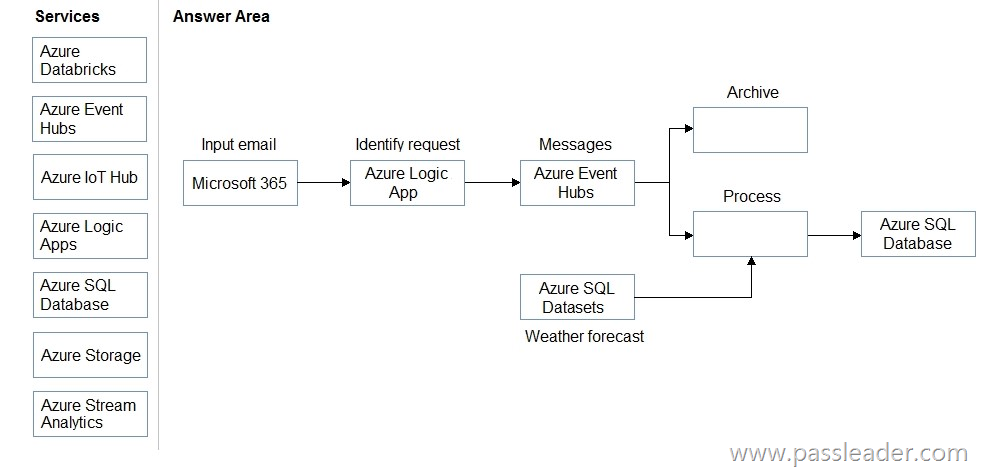Valid DP-201 Dumps shared by PassLeader for Helping Passing DP-201 Exam! PassLeader now offer the newest DP-201 VCE dumps and DP-201 PDF dumps, the PassLeader DP-201 exam questions have been updated and ANSWERS have been corrected, get the newest PassLeader DP-201 dumps with VCE and PDF here: https://www.passleader.com/dp-201.html (201 Q&As Dumps –> 223 Q&As Dumps)
BTW, DOWNLOAD part of PassLeader DP-201 dumps from Cloud Storage: https://drive.google.com/open?id=1VdzP5HksyU93Arqn65qPe5UFEm2Sxooh
NEW QUESTION 185
You are planning a solution that combines log data from multiple systems. The log data will be downloaded from an API and stored in a data store. You plan to keep a copy of the raw data as well as some transformed versions of the data. You expect that there will be at least 2 TB of log files. The data will be used by data scientists and applications. You need to recommend a solution to store the data in Azure. The solution must minimize costs. What storage solution should you recommend?
A. Azure Data Lake Storage Gen2
B. Azure Synapse Analytics
C. Azure SQL Database
D. Azure Cosmos DB
Answer: A
Explanation:
To land the data in Azure storage, you can move it to Azure Blob storage or Azure Data Lake Store Gen2. In either location, the data should be stored in text files. PolyBase and the COPY statement can load from either location.
Incorrect:
Not B: Azure Synapse Analytics, uses distributed query processing architecture that takes advantage of the scalability and flexibility of compute and storage resources. Use Azure Synapse Analytics transform and move the data.
https://docs.microsoft.com/en-us/azure/synapse-analytics/sql-data-warehouse/design-elt-data-loading
NEW QUESTION 186
You are designing a serving layer for data. The design must meet the following requirements:
– Authenticate users by using Azure Active Directory (Azure AD).
– Serve as a hot path for data.
– Support query scale out.
– Support SQL queries.
What should you include in the design?
A. Azure Data Lake Storage
B. Azure Cosmos DB
C. Azure Blob Storage
D. Azure Synapse Analytics
Answer: B
Explanation:
Do you need serving storage that can serve as a hot path for your data? If yes, narrow your options to those that are optimized for a speed serving layer. This would be Cosmos DB among the options given in this question. Note: Analytical data stores that support querying of both hot-path and cold-path data are collectively referred to as the serving layer, or data serving storage.
Incorrect:
Not A and C: Azure Data Lake Storage & Azure Blob storage are not data serving storage in Azure.
https://docs.microsoft.com/en-us/azure/architecture/data-guide/technology-choices/analytical-data-stores
NEW QUESTION 187
You are designing a storage solution for streaming data that is processed by Azure Databricks. The solution must meet the following requirements:
– The data schema must be fluid.
– The source data must have a high throughput.
– The data must be available in multiple Azure regions as quickly as possible.
What should you include in the solution to meet the requirements?
A. Azure Cosmos DB
B. Azure Synapse Analytics
C. Azure SQL Database
D. Azure Data Lake Storage
Answer: A
Explanation:
Azure Cosmos DB is Microsoft’s globally distributed, multi-model database. Azure Cosmos DB enables you to elastically and independently scale throughput and storage across any number of Azure’s geographic regions. It offers throughput, latency, availability, and consistency guarantees with comprehensive service level agreements (SLAs). You can read data from and write data to Azure Cosmos DB using Databricks. Note on fluid schema: If you are managing data whose structures are constantly changing at a high rate, particularly if transactions can come from external sources where it is difficult to enforce conformity across the database, you may want to consider a more schema-agnostic approach using a managed NoSQL database service like Azure Cosmos DB.
https://docs.databricks.com/data/data-sources/azure/cosmosdb-connector.html
https://docs.microsoft.com/en-us/azure/cosmos-db/relational-nosql
NEW QUESTION 188
You are designing a log storage solution that will use Azure Blob storage containers. CSV log files will be generated by a multi-tenant application. The log files will be generated for each customer at five-minute intervals. There will be more than 5,000 customers. Typically, the customers will query data generated on the day the data was created. You need to recommend a naming convention for the virtual directories and files. The solution must minimize the time it takes for the customers to query the log files. What naming convention should you recommend?
A. {year}/{month}/{day}/{hour}/{minute}/{CustomerID}.csv
B. {year}/{month}/{day}/{CustomerID}/{hour}/{minute}.csv
C. {minute}/{hour}/{day}/{month}/{year}/{CustomeriD}.csv
D. {CustomerID}/{year}/{month}/{day}/{hour}/{minute}.csv
Answer: B
Explanation:
https://docs.microsoft.com/en-us/azure/cdn/cdn-azure-diagnostic-logs
NEW QUESTION 189
You are designing an anomaly detection solution for streaming data from an Azure IoT hub. The solution must meet the following requirements:
– Send the output to Azure Synapse.
– Identify spikes and dips in time series data.
– Minimize development and configuration effort.
Which should you include in the solution?
A. Azure Databricks
B. Azure Stream Analytics
C. Azure SQL Database
Answer: B
Explanation:
You can identify anomalies by routing data via IoT Hub to a built-in ML model in Azure Stream Analytics.
https://docs.microsoft.com/en-us/learn/modules/data-anomaly-detection-using-azure-iot-hub/
NEW QUESTION 190
You have an Azure Databricks workspace named workspace1 in the Standard pricing tier. Workspace1 contains an all-purpose cluster named cluster1. You need to reduce the time it takes for cluster1 to start and scale up. The solution must minimize costs. What should you do first?
A. Upgrade workspace1 to the Premium pricing tier.
B. Create a pool in workspace1.
C. Configure a global init script for workspace1.
D. Create a cluster policy in workspace1.
Answer: B
Explanation:
Databricks Pools increase the productivity of both Data Engineers and Data Analysts. With Pools, Databricks customers eliminate slow cluster start and auto-scaling times. Data Engineers can reduce the time it takes to run short jobs in their data pipeline, thereby providing better SLAs to their downstream teams.
https://databricks.com/blog/2019/11/11/databricks-pools-speed-up-data-pipelines.html
NEW QUESTION 191
You have a large amount of sensor data stored in an Azure Data Lake Storage Gen2 account. The files are in the Parquet file format. New sensor data will be published to Azure Event Hubs. You need to recommend a solution to add the new sensor data to the existing sensor data in real-time. The solution must support the interactive querying of the entire dataset. Which type of server should you include in the recommendation?
A. Azure SQL Database
B. Azure Cosmos DB
C. Azure Stream Analytics
D. Azure Databricks
Answer: C
Explanation:
Azure Stream Analytics is a fully managed PaaS offering that enables real-time analytics and complex event processing on fast moving data streams. By outputting data in parquet format into a blob store or a data lake, you can take advantage of Azure Stream Analytics to power large scale streaming extract, transfer, and load (ETL), to run batch processing, to train machine learning algorithms, or to run interactive queries on your historical data.
https://azure.microsoft.com/en-us/blog/new-capabilities-in-stream-analytics-reduce-development-time-for-big-data-apps/
NEW QUESTION 192
You are designing a solution that will copy Parquet files stored in an Azure Blob storage account to an Azure Data Lake Storage Gen2 account. The data will be loaded daily to the data lake and will use a folder structure of {Year}/{Month}/{Day}/. You need to design a daily Azure Data Factory data load to minimize the data transfer between the two accounts. Which two configurations should you include in the design? (Each correct answer presents part of the solution. Choose two.)
A. Delete the files in the destination before loading new data.
B. Filter by the last modified date of the source files.
C. Delete the source files after they are copied.
D. Specify a file naming pattern for the destination.
Answer: BC
Explanation:
B: To copy a subset of files under a folder, specify folderPath with a folder part and fileName with a wildcard filter.
C: After completion: Choose to do nothing with the source file after the data flow runs, delete the source file, or move the source file. The paths for the move are relative.
https://docs.microsoft.com/en-us/azure/data-factory/connector-azure-data-lake-storage
NEW QUESTION 193
You have a C# application that process data from an Azure IoT hub and performs complex transformations. You need to replace the application with a real-time solution. The solution must reuse as much code as possible from the existing application. Which tool should you include in the recommendation?
A. Azure Databricks
B. Azure Event Grid
C. Azure Stream Analytics
D. Azure Data Factory
Answer: C
Explanation:
Azure Stream Analytics on IoT Edge empowers developers to deploy near-real-time analytical intelligence closer to IoT devices so that they can unlock the full value of device-generated data. UDF are available in C# for IoT Edge jobs. Azure Stream Analytics on IoT Edge runs within the Azure IoT Edge framework. Once the job is created in Stream Analytics, you can deploy and manage it using IoT Hub.
https://docs.microsoft.com/en-us/azure/stream-analytics/stream-analytics-edge
NEW QUESTION 194
A company purchases IoT devices to monitor manufacturing machinery. The company uses an IoT appliance to communicate with the IoT devices. The company must be able to monitor the devices in real-time. You need to design the solution. What should you recommend?
A. Azure Data Factory instance using Azure Portal.
B. Azure Analysis Services using Microsoft Visual Studio.
C. Azure Stream Analytics cloud job using Azure Portal.
D. Azure Data Factory instance using Azure Portal.
Answer: C
Explanation:
The Stream Analytics query language allows to perform CEP (Complex Event Processing) by offering a wide array of functions for analyzing streaming data. This query language supports simple data manipulation, aggregation and analytics functions, geospatial functions, pattern matching and anomaly detection. You can edit queries in the portal or using our development tools, and test them using sample data that is extracted from a live stream. Note: Stream Analytics is a cost-effective event processing engine that helps uncover real-time insights from devices, sensors, infrastructure, applications and data quickly and easily. Monitor and manage Stream Analytics resources with Azure PowerShell cmdlets and powershell scripting that execute basic Stream Analytics tasks.
https://cloudblogs.microsoft.com/sqlserver/2014/10/29/microsoft-adds-iot-streaming-analytics-data-production-and-workflow-services-to-azure/
https://docs.microsoft.com/en-us/azure/stream-analytics/stream-analytics-introduction
NEW QUESTION 195
You are designing a storage solution to store CSV files. You need to grant a data scientist access to read all the files in a single container of an Azure Storage account. The solution must use the principle of least privilege and provide the highest level of security. What are two possible ways to achieve the goal? (Each correct answer presents part of the solution. Choose two.)
A. Provide an access key.
B. Assign the Storage Blob Data Reader role at the container level.
C. Assign the Reader role to the storage account.
D. Provide an account shared access signature (SAS).
E. Provide a user delegation shared access signature (SAS).
Answer: BE
Explanation:
B: When an Azure role is assigned to an Azure AD security principal, Azure grants access to those resources for that security principal. Access can be scoped to the level of the subscription, the resource group, the storage account, or an individual container or queue. The built-in Data Reader roles provide read permissions for the data in a container or queue. Note: Permissions are scoped to the specified resource. For example, if you assign the Storage Blob Data Reader role to user Mary at the level of a container named sample-container, then Mary is granted read access to all of the blobs in that container.
E: A user delegation SAS is secured with Azure Active Directory (Azure AD) credentials and also by the permissions specified for the SAS. A user delegation SAS applies to Blob storage only.
https://docs.microsoft.com/en-us/azure/storage/common/storage-auth-aad-rbac-portal
https://docs.microsoft.com/en-us/azure/storage/common/storage-sas-overview
NEW QUESTION 196
You are designing an Azure Synapse solution that will provide a query interface for the data stored in an Azure Storage account. The storage account is only accessible from a virtual network. You need to recommend an authentication mechanism to ensure that the solution can access the source data. What should you recommend?
A. a shared key
B. an Azure Active Directory (Azure AD) service principal
C. a shared access signature (SAS)
D. anonymous public read access
Answer: B
Explanation:
Managed Identity authentication is required when your storage account is attached to a VNet. Regardless of the type of identity chosen a managed identity is a service principal of a special type that may only be used with Azure resources. Note: An Azure service principal is an identity created for use with applications, hosted services, and automated tools to access Azure resources.
https://docs.microsoft.com/en-us/azure/synapse-analytics/sql-data-warehouse/quickstart-bulk-load-copy-tsql-examples
https://docs.microsoft.com/en-us/powershell/azure/create-azure-service-principal-azureps
NEW QUESTION 197
You plan to implement an Azure Data Lake Gen2 storage account. You need to ensure that the data lake will remain available if a data center fails in the primary Azure region. The solution must minimize costs. Which type of replication should you use for the storage account?
A. geo-redundant storage (GRS)
B. zone-redundant storage (ZRS)
C. locally-redundant storage (LRS)
D. geo-zone-redundant storage (GZRS)
Answer: A
Explanation:
Geo-redundant storage (GRS) copies your data synchronously three times within a single physical location in the primary region using LRS. It then copies your data asynchronously to a single physical location in the secondary region.
Incorrect:
Not B: Zone-redundant storage (ZRS) copies your data synchronously across three Azure availability zones in the primary region. For applications requiring high availability, Microsoft recommends using ZRS in the primary region, and also replicating to a secondary region.
Not C: Locally redundant storage (LRS) copies your data synchronously three times within a single physical location in the primary region. LRS is the least expensive replication option, but is not recommended for applications requiring high availability.
Not D: GZRS is more expensive compared to GRS.
https://docs.microsoft.com/en-us/azure/storage/common/storage-redundancy
NEW QUESTION 198
Hotspot
You are designing a solution to process data from multiple Azure event hubs in near real-time. Once processed, the data will be written to an Azure SQL database. The solution must meet the following requirements:
– Support the auditing of resource and data changes.
– Support data versioning and rollback.
What should you recommend? (To answer, select the appropriate options in the answer area.)
Answer:

Explanation:
Box 1: Azure Stream Analytics. Users can now ingest, process, view, and analyze real-time streaming data into a table directly from a database in Azure SQL Database. They do so in the Azure portal using Azure Stream Analytics. In the Azure portal, you can select an events source (Event Hub/IoT Hub), view incoming real-time events, and select a table to store events. Stream Analytics leverages versioning of reference data to augment streaming data with the reference data that was valid at the time the event was generated. This ensures repeatability of results.
Box 2: Replay. Reference data is versioned, enabling to always get the same results, even when we “replay” the stream.
https://docs.microsoft.com/en-us/azure/azure-sql/database/stream-data-stream-analytics-integration
https://azure.microsoft.com/en-us/updates/additional-support-for-managed-identity-and-new-features-in-azure-stream-analytics/
NEW QUESTION 199
Drag and Drop
You are designing a real-time processing solution for maintenance work requests that are received via email. The solution will perform the following actions:
– Store all email messages in an archive.
– Access weather forecast data by using the Python SDK for Azure Open Datasets.
– Identify high priority requests that will be affected by poor weather conditions and store the requests in an Azure SQL database.
The solution must minimize costs. How should you complete the solution? (To answer, drag the appropriate services to the correct locations. Each service may be used once, more than once, or not at all. You may need to drag the split bar between panes or scroll to view content.)
Answer:

Explanation:
Box 1: Azure Storage. Azure Event Hubs enables you to automatically capture the streaming data in Event Hubs in an Azure Blob storage or Azure Data Lake Storage Gen 1 or Gen 2 account of your choice, with the added flexibility of specifying a time or size interval. Setting up Capture is fast, there are no administrative costs to run it, and it scales automatically with Event Hubs throughput units. Event Hubs Capture is the easiest way to load streaming data into Azure, and enables you to focus on data processing rather than on data capture.
Box 2: Azure Logic Apps. You can monitor and manage events sent to Azure Event Hubs from inside a logic app with the Azure Event Hubs connector. That way, you can create logic apps that automate tasks and workflows for checking, sending, and receiving events from your Event Hub.
https://docs.microsoft.com/en-us/azure/event-hubs/event-hubs-capture-overview
https://docs.microsoft.com/en-us/azure/connectors/connectors-create-api-azure-event-hubs
NEW QUESTION 200
……
Get the newest PassLeader DP-201 VCE dumps here: https://www.passleader.com/dp-201.html (201 Q&As Dumps –> 223 Q&As Dumps)
And, DOWNLOAD the newest PassLeader DP-201 PDF dumps from Cloud Storage for free: https://drive.google.com/open?id=1VdzP5HksyU93Arqn65qPe5UFEm2Sxooh

